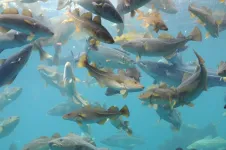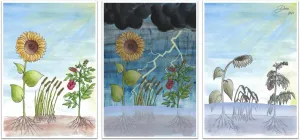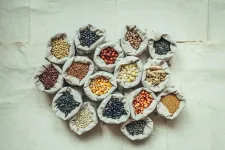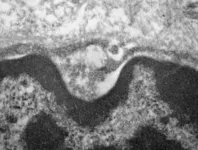Predicting the future of cod
Hereon scientists develop new fisheries management planning tool -- fewer stocks expected
2021-07-06
(Press-News.org) The future of cod stocks in the North Sea and the Barents Sea may be much easier to predict than before. This is the result of an international research project led by the Helmholtz-Zentrum Hereon and its Institute of Coastal Systems - Analysis and Modeling. For the first time, the team has succeeded in predicting the development of stocks for ten years in advance, taking into account both changes due to climate and fishing. Traditionally, fisheries experts provide catch recommendations for about a year in advance, on the basis of which fishing quotas are negotiated and set internationally. This involves first estimating the size of current cod stocks and then calculating how much cod can be caught in the coming year without endangering the stocks as well as harvesting the stock optimally. The climatic change, long-term changes in water temperature, circulation and mixing, which have a decisive influence on how well cod reproduce, are not included in this prediction, so that the development of stocks can only be predicted in the short term.
Warm North Sea causes stress
As the experts around climate modeler Vimal Koul und Corinna Schrum of Hereon now write in the journal Nature Communications Earth and Environment, they have taken temperature into account in their calculations. For the North Sea, the climate forecast continues to predict temperatures at a high level, so that cod stocks are unlikely to recover or reach earlier levels. As a result, catches are expected to remain low. Things look better for the Barents Sea, where stocks can be managed sustainably.
For the researchers, the challenge was that climate models cannot calculate how much fish there will be in the oceans in the future. They only provide information about expected temperatures. "So we first had to develop a program that translates water temperature into fish quantities," says Vimal Koul. Among other things, this took into account the ocean temperature in the North Atlantic. The researchers were then able to run their prediction model. The model starts with today's conditions - the current temperature conditions and the current carbon dioxide content of the atmosphere, and can then calculate how the situation will change as carbon dioxide concentrations increase. The future temperatures are then translated into expected fish abundance and stock sizes.
To test how reliably the model works, it was first compared with real fish data from the 1960s to the present. As it turned out, it was able to correctly estimate fish stocks for the ten-year periods since the early 1960s. In this respect, the researchers led by Vimal Koul can assume that the current view of the coming ten years is also correct.
Fishing intensity taken into account
Another interesting aspect of the study is that the team of climate modelers, fisheries biologists and oceanographers took four different fishing scenarios into account. This allowed them to determine how cod stocks would fare if they were fished at different levels - from intensive to sustainable. In this respect, the results of the current study are very practical. "The 10-year estimates will help the fishing industry better plan catches in the future - so that cod stocks are fished sustainably and gently despite changes in climate," says Vimal Koul. The new 10-year calculation model could also help fishing companies in their strategic planning - by providing a secure basis for investments in new vessels or processing facilities.
INFORMATION:
[Attachments] See images for this press release:

ELSE PRESS RELEASES FROM THIS DATE:
2021-07-06
Climate change is causing increased flooding and prolonged waterlogging in northern Europe, but also in many other parts of the world. This can damage meadow grasses, field crops or other plants - their leaves die, the roots rot.
The damage is caused by a lack of oxygen and the accumulation of acids. How do plants perceive this over-acidification, how do they react to it? This is what researchers from Würzburg, Jena (Germany) and Talca (Chile) describe in the journal Current Biology.
Biophysicists Dr. Tobias Maierhofer and Professor Rainer Hedrich from the Chair of Molecular Plant Physiology and Biophysics at Julius-Maximilians-Universität ...
2021-07-06
For the first time, University of Basel researchers have equipped an ultrathin semiconductor with superconducting contacts. These extremely thin materials with novel electronic and optical properties could pave the way for previously unimagined applications. Combined with superconductors, they are expected to give rise to new quantum phenomena and find use in quantum technology.
Whether in smartphones, televisions or building technology, semiconductors play a central role in electronics and therefore in our everyday lives. In contrast to metals, it is possible to adjust their electrical conductivity by applying a voltage and hence to switch the current flow on and off.
With a view to future applications in electronics and quantum technology, researchers are focusing on the development ...
2021-07-06
Abu Dhabi, UAE, July 5, 2021: NYU Abu Dhabi (NYUAD) researchers uncovered a code that sets the genome of the liver to account for the remarkable ability for this organ to regenerate. This finding offers new insight into how the specific genes that promote regeneration can be activated when part of the liver is removed. These findings have the potential to inform the development of a new form of regenerative medicine that could help non-regenerative organs regrow in mice and humans.
While other animals can regenerate most organs, humans, mice, and other mammals can only regenerate their liver in response to an injury or when a piece is removed. NYUAD researchers ...
2021-07-06
Post-traumatic stress disorder (PTSD) rings a bell for many, due to its rampant references in pop culture, and more, importantly, its prevalence in today's society. It is only probable that this disorder, which develops after shocking or dangerous events, would unfortunately affect the lives of many people. Medical researchers have been hard at work trying to come up with solutions to combat this condition and its manifestations effectively. Unfortunately, the neurological mechanisms of PTSD aren't clear, and without knowing this exactly, trying to find a cure is a shot in the dark.
Fortunately, a group ...
2021-07-06
"Plant a hundred kinds of crops"
Wangjinzhuang village is nestled amongst the steep slopes of the South Taihang Mountains in Hebei Province, China. To prosper in the northern climate, the villagers have developed a tried-and-true strategy: "using the land to plant a hundred kinds of crops and not rely on the sky". Their fields contain red millet, white sorghum, purple and green eyebrow beans, and yellow radishes. Having survived for over a thousand years, this agrobiodiversity is a vibrant cornerstone of the village's agricultural heritage that is too precious to lose.
In an effort to combat dwindling crop diversity across China (the Ministry of Agriculture found that of 11,590 grain crop varieties planted ...
2021-07-06
Cardiovascular drugs do not affect COVID-19 outcomes--such as disease severity, hospitalizations, or deaths--according to an analysis of all relevant studies published as of November 2020. The findings are published in the END ...
2021-07-06
BOSTON - Significant amounts of atherosclerotic plaque have been found in the coronary arteries of people with HIV, even in those considered by traditional measures to be at low-to-moderate risk of future heart disease, according to a study published in JAMA Network Open.
This finding emerged from the global REPRIEVE (Randomized Trial to Prevent Vascular Events in HIV) study, in which Massachusetts General Hospital (MGH) is playing a key coordinating role. Researchers found that the higher-than-expected levels of plaque could not be attributed simply to traditional cardiovascular disease risk factors like smoking, hypertension, and lipids in the blood, but were independently related to increased arterial inflammation ...
2021-07-06
The expected decline in the number of landfills across the United States coupled with bans on disposing large amounts of organic waste in landfills that have been enacted in multiple states has prompted researchers at the U.S. Department of Energy's (DOE's) National Renewable Energy Laboratory (NREL) to examine other ways to grapple with the issue of food waste disposal.
The researchers determined no single solution exists in the United States for dealing with food waste disposal. NREL researchers Alex Badgett and Anelia Milbrandt came to that conclusion after examining the economics involved in five different ways to ...
2021-07-06
In Brazil, researchers at the University of São Paulo’s Medical School (FM-USP) have discovered that SARS-CoV-2 infects and replicates in the salivary glands.
Analysis of samples from three types of salivary gland obtained during a minimally invasive autopsy procedure performed on patients who died from complications of COVID-19 at Hospital das Clínicas, FM-USP’s hospital complex, showed that tissues specializing in producing and secreting saliva serve as reservoirs for the novel coronavirus.
The study was supported by FAPESP and reported in an article published in the Journal of Pathology.
The researchers said the discovery ...
2021-07-06
Bioenergy crops are an alternative energy source that, unlike fossil fuels, could positively impact the environment by reducing greenhouse gases, soil erosion, and carbon dioxide levels. They can be produced even more sustainably if they are grown on poor quality land unsuitable for food. To make up for the poor land quality, these crops can rely on soil microbes like bacteria and fungi to help them access nutrients and water and store more carbon.
Switchgrass, a native prairie species, is championed as a promising bioenergy crop due to its ability to grow across many climates. ...
LAST 30 PRESS RELEASES:
[Press-News.org] Predicting the future of cod
Hereon scientists develop new fisheries management planning tool -- fewer stocks expected





